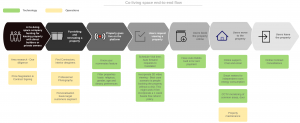The term “co-living” refers to shared and fully furnished residential real estate offerings with communal facilities with ready-to-move-in setup. Primary target customers are single individuals who want to rent without a long term commitment. The aim is to bypass cultural barriers/stigmas surfacing old generation homeowners while offering high standard accommodation, safety, privacy, better care services, and community. Some even offer cleaning and food services.
Since the past decade, the co-working trend is slowly disrupting traditional approaches in both commercial and residential leasing segment. The boom in startups and real estate have gone hand-in-hand balancing demand and supply more or less. However, when it comes to single tenants, the demand-supply gap is evident. This is because of the stereotype – Bachelors are problem-makers and lack of trust. One thing that hasn’t improved much in the traditional setup is the quality, comfort and trust aspect of renting a living place. Accommodation alternatives are rapidly emerging with Oyo, Coho, Zolo, NestAway, and Stanza living being the primary players solving comfort, trust, and quality issues.
The offerings in the market so far are broadly classified into Single Occupancy, Multi Occupancy, Apartments, and houses. The current focus is primarily on students and working professionals. Not much emphasis is laid on customisation, and other segments of customers – corporates, remote workers, couples – married or live-in, and luxury stays.
Co-living space segment is operational heavy and hence scaling is an uphill challenge. Product management in hybrid Technology/Operations industry requires a different type of approach than pure tech products. Big techs like Flipkart, Ola, Swiggy, AirBnB, and Grofers have one similarity – they are all heavy on operational infrastructure and technology serves as an enabler providing a gateway and top-notch experience to consumers and providers. Technology bridges the gap between consumers, providers and the core offering.
Let us understand the overall journey and operational needs –
- A Co-living space company hunting for leasing property with direct builders or private owners – Price negotiation, Contract signing
- Furnishing and renovating a property
- Property goes live on the platform
- Users request viewing
- Users book the property online
- Users arrive from outstation or locals – Users may have past furniture belongings, Users sell belongings
- Users use relocation service providers services to move belongings
- Users move to the property
- Users leave the property
To provide a seamless experience to customers, companies have to blend and effectively balance operations and technology pieces. Automation of processes would help scaling business in new locations keeping operations headcount low.
B2B segment is still an untapped market. Co-living spaces can tie-up with few companies and offer their premium properties on short term rentals on the fly. USP that can differentiate co-living spaces from hotels and serviced apartments is the low pricing. There is an on-going demand from corporates sending employees on deputation, training, meetings, conferences to a different city.
Another untapped market is remote workers. Touristic places like Dharamshala, Goa and Kerala have potential to attract digital nomads both locals and foreigners, digital freelancers, and remote workers. Internet speed in these places is still not sufficient to cater to the needs of remote workers. Co-living spaces can be designed in a way that offers the advantages of both co-living and co-working spaces. A demand can definitely be created for new accommodation options and innovative services to accompany them. To attract foreigner nomads, the service offerings have to match in standard, price and comfort variables with other southeast Asian popular cities namely Chiang Mai, Ubud, and Bali. Flexibility, Mobility, Quality, and price is something that has to go hand-in-hand.
As the zillennial demographic reaches their prime spending years, they present plenty of opportunities for companies looking ahead to disrupt the traditional market. It’s crucial to consider their needs and to start work early on the products and services that will replace the norms set by their predecessors. More competition in the market may help in keeping the prices and offerings competitive, address the high rental cost crisis in certain key areas in metro cities.
In designing for the young generations driving the trend, the key component is understanding what’s important and valuable to them as a demographic. One size fits all may not be the best solution. Great location with proximity to public transport, on-site co-working spaces, recreational facilities, kitchen, common area, laundry services are some of the things that can help attract first-timers. Co-living is a heavy investment game and would yield significant returns only in the long run.


